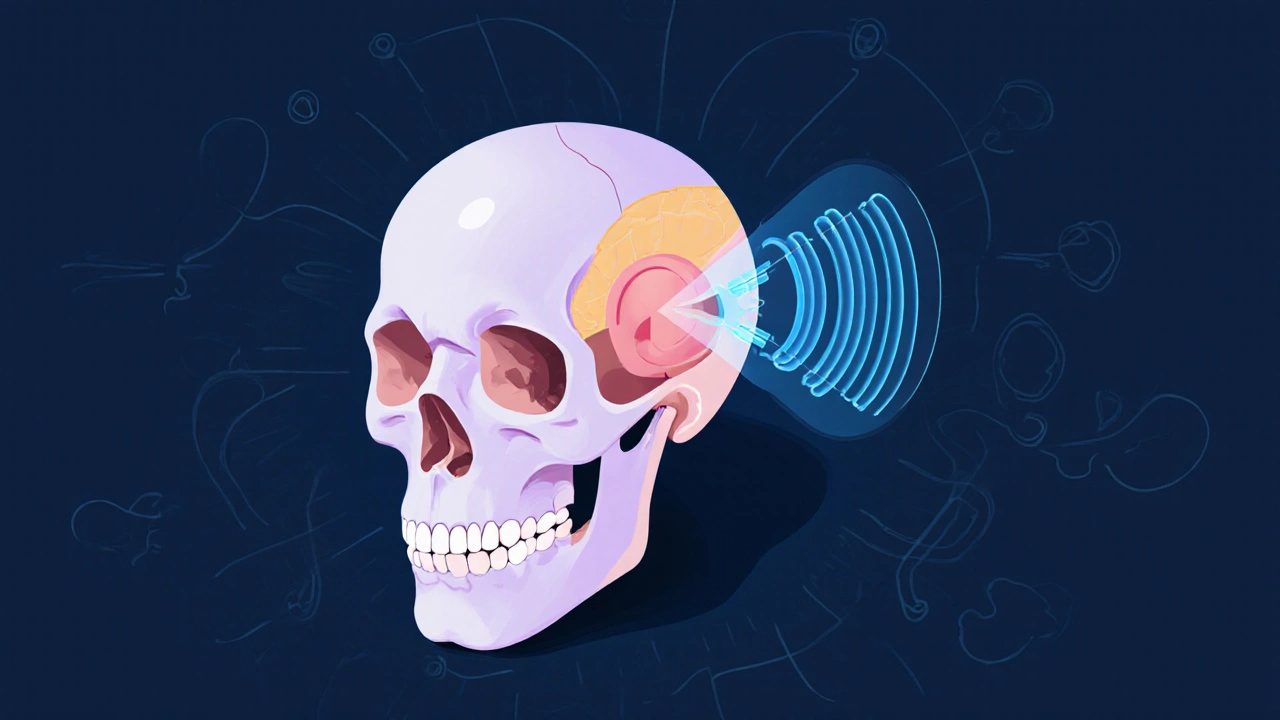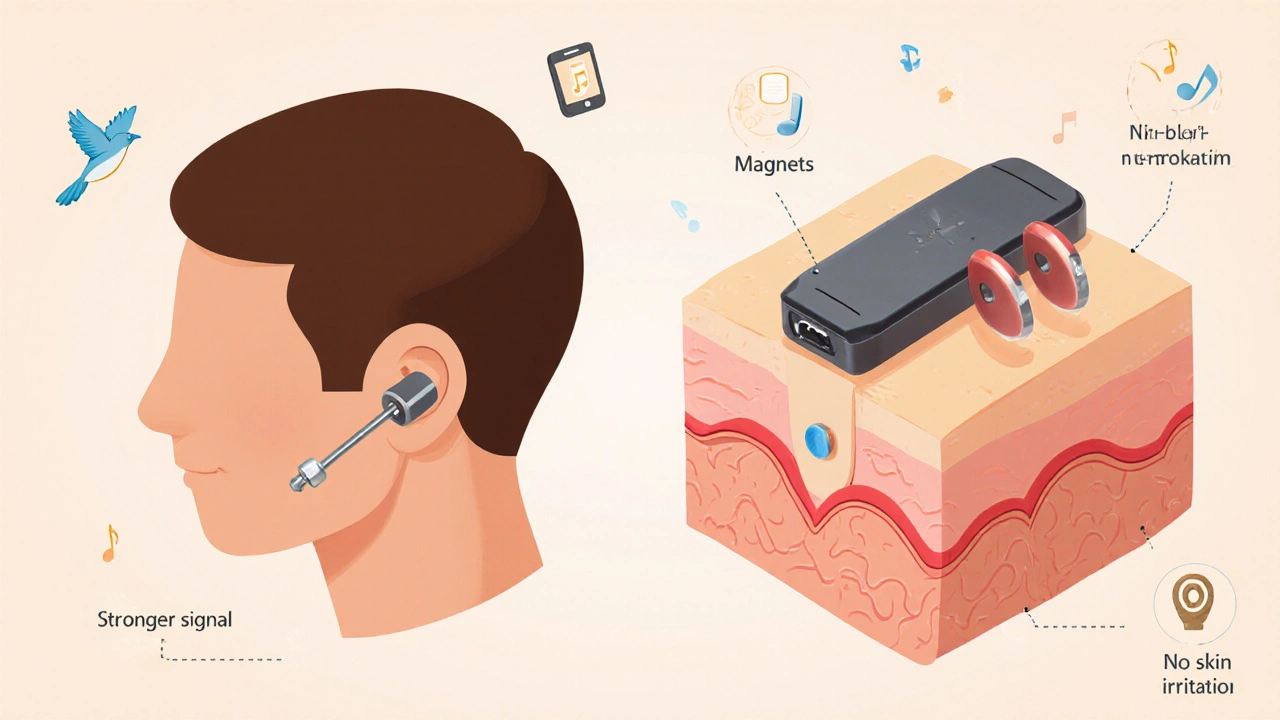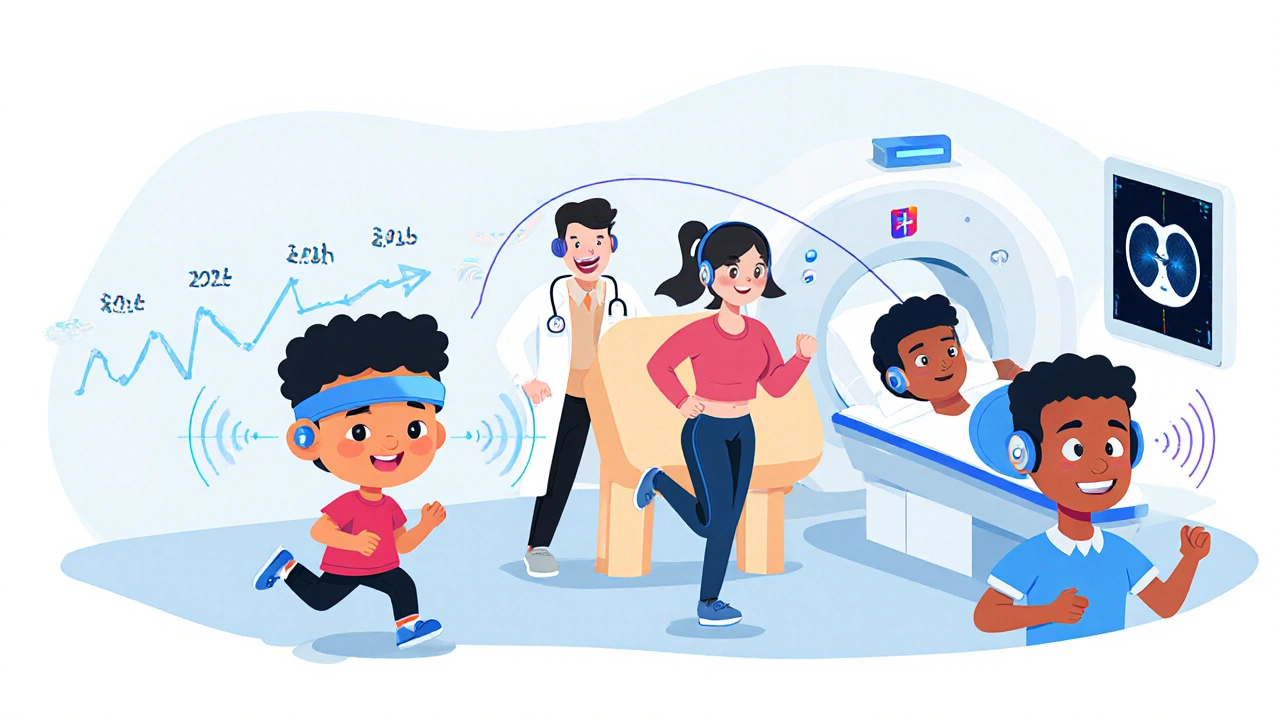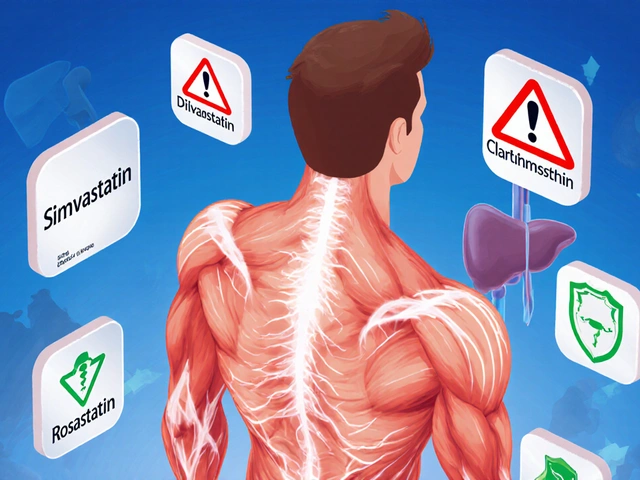Bone-Conduction Hearing Aids: A Practical Alternative for Hearing Loss

Most people think hearing aids go in your ear. But what if the solution doesn’t need to go in your ear at all? Bone-conduction hearing aids work by sending sound straight through your skull bone to your inner ear, skipping the outer and middle ear entirely. This isn’t science fiction-it’s a proven, FDA-approved option for people who can’t use traditional hearing aids because of chronic ear infections, birth defects, or single-sided deafness.
How Bone-Conduction Hearing Aids Actually Work
Sound normally travels through the air, into your ear canal, vibrates your eardrum, and moves tiny bones in your middle ear before reaching the cochlea. But if your ear canal is blocked, your eardrum is damaged, or your middle ear bones don’t move right, that path breaks down. That’s where bone conduction comes in.
Instead of air, these devices use vibrations. A small processor picks up sound, turns it into vibrations, and sends them through the bone behind your ear. Those vibrations travel directly to the cochlea-the part of your inner ear that turns sound into signals your brain understands. It’s like tapping on your skull and hearing the sound from inside your head.
This method bypasses everything that’s broken or infected. No ear molds. No wax buildup. No blocked canals. For people with conductive hearing loss or mixed hearing loss, this isn’t just an alternative-it’s often the only option that works.
Who Benefits Most From Bone-Conduction Devices
These aren’t for everyone. But for specific groups, they’re life-changing.
- Chronic ear infections: If you’ve had recurring infections that make wearing traditional hearing aids painful or impossible, bone conduction avoids the ear canal completely. Studies show 92% of these patients can’t use regular aids-bone conduction is their only viable solution.
- Congenital aural atresia: Some people are born without a fully formed ear canal. Around 85-90% of these patients get clear, usable hearing with bone-conduction devices.
- Single-sided deafness (SSD): If you’ve lost hearing in one ear, traditional hearing aids can’t help. CROS aids (which pick up sound from the deaf side and send it to the good ear) exist, but they don’t sound natural. Bone conduction lets you hear sounds from both sides. Users report hearing birds chirp on their deaf side for the first time in years.
It’s not magic. If your cochlea is severely damaged-say, from noise exposure or aging-bone conduction won’t help much. It needs a working inner ear. But if your problem is in the outer or middle ear, this technology fills a gap no other device can.
Percutaneous vs. Transcutaneous: Two Very Different Systems
There are two main types of bone-conduction devices, and they’re built differently.
Percutaneous systems (like Cochlear’s BAHA Connect and Oticon’s Ponto) use a titanium implant fused to your skull bone. After surgery, a small metal post sticks out through your skin. The sound processor snaps onto it. These give you the strongest signal-up to 50 dB of gain-and are ideal for severe hearing loss. But that exposed post can get irritated. About 15-30% of users develop skin reactions, and 8% need revision surgery.
Transcutaneous systems (like MED-EL’s Bonebridge and Cochlear’s BAHA Attract) use magnets. The implant sits under your skin, and the external processor holds on via magnetic force. No open wound. No daily cleaning of an abutment. Skin complications drop to under 5%. But because the sound has to pass through skin and tissue, you lose about 10-15 dB of volume. That’s fine for mild to moderate loss, but not enough for severe cases.
Here’s the shift happening right now: in 2019, only 41% of new bone-conduction implants were transcutaneous. By 2023, that number jumped to 63%. Why? People want to avoid the hassle and risk of an open wound. The trade-off? Less power. But for most users, the comfort wins.

Cost, Surgery, and Real-World Challenges
These aren’t cheap. Implantable bone-conduction devices cost between $4,000 and $7,000 per ear. Compare that to $1,500-$3,500 for high-end air-conduction hearing aids. Insurance often covers them if you meet medical criteria-like documented ear infections or congenital malformations-but you’ll need a detailed evaluation from an audiologist and ENT.
Surgery is minor but real. It takes 30-60 minutes under local anesthesia. Most people go home the same day. For percutaneous systems, you wait 3-4 months for the bone to fuse with the implant before turning it on. Transcutaneous systems can be activated right away.
Once you’re fitted, there’s a learning curve. The sound feels different-more like you’re hearing yourself talk from inside your head. Most users adapt in 2-4 weeks. Audiologists recommend daily listening exercises during that time.
Biggest complaints? MRI scans. Most implants are MRI-incompatible above 1.5T. You’ll need surgery to remove the magnet or abutment before a scan. And for active users, the processor can loosen during exercise. Some report it falling off during running or swimming.
What’s New in 2025
The tech is getting smarter.
Cochlear’s BAHA 6 Max, released in 2023, now has Bluetooth 5.3, so you can stream calls and music directly from your phone. Battery life is up to 30 hours. MED-EL’s Bonebridge 3, coming in Q2 2024, uses AI to filter background noise in real time-something no other bone-conduction device does yet.
The biggest trend? Fully implantable systems. Right now, you still wear an external processor. But Sonova’s device, currently in Phase III trials, aims to eliminate that. No external part at all. Just a tiny implant under the skin that picks up sound, processes it, and sends vibrations-all hidden. If approved by the FDA in late 2024, this could be the next big leap.
Market data shows bone conduction is growing faster than traditional hearing aids-8.7% annual growth versus 4.3%. Only 0.4% of hearing-impaired Americans use it now, but that’s rising. Why? More awareness. More doctors recognizing single-sided deafness as treatable. And more people demanding solutions that don’t block their ears or cause infections.

Real People, Real Results
Reddit threads from the r/Hearing community in late 2023 show a clear pattern. Of 142 recent posts from bone-conduction users, 78% said their quality of life improved dramatically. One user wrote: "I heard my daughter call my name from behind me for the first time since I was 19. I cried for 20 minutes."
On HearGear.com, 65% of positive reviews mention "natural sound quality." Eighty-two percent of users with chronic ear infections say they finally feel free from pain and itching.
But it’s not perfect. Twenty-three percent of users on HearingTracker.com complain about MRI limitations. And while transcutaneous systems have fewer skin issues, 8% of percutaneous users still need surgery to fix infections or loose implants.
The takeaway? If you’ve been told there’s no solution for your hearing loss, bone conduction might be it. It’s not a cure. But for the right person, it’s the difference between living with silence and hearing the world again.
What to Do Next
If you think this might help you or someone you know:
- See an audiologist who specializes in hearing loss-not just general hearing aid fitting. Ask if they’ve worked with bone-conduction devices.
- Get a full hearing test and a CT scan of your temporal bone. This shows if your skull bone is thick enough to support an implant.
- Ask about insurance coverage. Many plans require a letter of medical necessity from your ENT.
- Try a non-surgical bone-conduction hearing aid first. Some clinics offer temporary headband versions (like the ADHEAR system) so you can test the sound before committing to surgery.
Don’t assume you’re out of options. If your ears are damaged, your cochlea might still be perfectly fine. Bone conduction doesn’t fix your ear-it bypasses it. And for thousands of people, that’s exactly what they needed.
Can bone-conduction hearing aids help with age-related hearing loss?
No, not typically. Age-related hearing loss (presbycusis) is sensorineural, meaning the problem is in the inner ear or nerve pathways. Bone-conduction devices need a healthy cochlea to work. If your cochlea is damaged from aging, noise, or disease, these devices won’t restore hearing. They’re designed for conductive or mixed hearing loss, where the inner ear is intact but sound can’t reach it.
Are bone-conduction devices visible?
It depends. Percutaneous systems have a small metal post sticking out behind the ear-visible unless covered by hair. Transcutaneous systems use magnets under the skin, so the external processor is the only visible part. It’s about the size of a large coin and clips on like a hearing aid. Most users say it’s less noticeable than traditional aids because it sits behind the ear, not inside it.
How long do bone-conduction devices last?
The implant is meant to last a lifetime. Titanium fuses with bone and doesn’t degrade. The external processor, however, is like a smartphone-it gets outdated. Most users upgrade every 5-7 years as battery life, Bluetooth, and noise-filtering tech improve. Replacement processors cost $2,500-$4,000, depending on the model and features.
Can children use bone-conduction hearing aids?
Yes, and they’re often the best option for kids with congenital ear malformations. Non-surgical headband versions (like ADHEAR or Softband) can be used from infancy. Surgical implants are typically placed after age 5, when the skull bone is thick enough. Early use improves speech development, and studies show children using bone conduction reach language milestones close to their peers with normal hearing.
Do these devices help with tinnitus?
Not directly. But many users report reduced tinnitus because the brain is getting more natural sound input. When your brain stops straining to hear, it often quiets down the phantom noise. Some devices include built-in sound therapy tones that can be customized to mask ringing. It’s not a cure, but for many, it’s a noticeable relief.






Comments (14)
shawn monroe
26 Nov 2025
Bone conduction is a game-changer for conductive loss-seriously, if your cochlea’s intact, this is the holy grail. BAHA 6 Max with Bluetooth 5.3? 🤯 I’ve been using mine since 2022, and streaming Spotify directly to my skull? Pure magic. No more earwax, no infections, just clean, crisp sound. The only downside? MRI nightmares. You’ll need surgery to remove the magnet if you ever need a full-body scan. But hey, hearing your kid laugh from behind you? Worth it. 💪
marie HUREL
27 Nov 2025
I never thought I’d say this, but after 15 years of chronic ear infections, I finally feel like I’m part of conversations again. I use the transcutaneous Bonebridge, and honestly, the lack of an open wound made all the difference. My skin doesn’t itch, I don’t have to clean it daily, and I can swim without panic. The sound is a little muffled compared to the percutaneous models, but for mild-moderate loss? Perfect. I’m just glad there’s finally a way that doesn’t feel like a compromise.
Lauren Zableckis
29 Nov 2025
I’ve been researching this for my brother who has single-sided deafness. He’s been living in silence on one side since he was 22. I showed him the Reddit thread about hearing birds again. He cried. We’re scheduling the audiologist next week. I just want him to know what it’s like to hear a car honk from his left side. It’s not about the tech-it’s about safety, awareness, and just being present in the world.
Asha Jijen
30 Nov 2025
this thing is wild like why didnt we do this 50 years ago its just vibrations through bone duh why are we still putting stuff in ears i mean its 2025 and we still have earbuds that get clogged with wax lol
Edward Batchelder
30 Nov 2025
As someone who’s worked in audiology for over two decades, I’ve seen every solution come and go. Bone conduction isn’t new-but its accessibility, affordability, and user-centered design are evolving faster than ever. What’s remarkable is how it restores not just hearing, but dignity. For children with atresia, early intervention with softbands can mean the difference between speech delays and academic parity. For adults with SSD, it’s not about volume-it’s about spatial awareness. This isn’t just technology. It’s inclusion.
reshmi mahi
1 Dec 2025
USA spending $7k on a skull vibrator while India still has kids with ear infections dying from antibiotics? 😂 maybe if you stopped making fancy tech for rich people and fixed basic healthcare first, we wouldn’t need this. But hey, at least you can stream TikTok through your skull. 🤡
laura lauraa
1 Dec 2025
It’s fascinating how society has normalized the commodification of disability. We don’t fix the environment-we build gadgets that let people adapt to broken systems. Bone conduction? A brilliant workaround. But why are we not investing in preventing ototoxicity, noise pollution, or access to ENT care? The real tragedy isn’t hearing loss-it’s the fact that we’ve turned survival into a luxury product with a $4,000 price tag and MRI restrictions. This isn’t progress. It’s capitalism dressed in medical terminology.
Gayle Jenkins
2 Dec 2025
If you’re even considering this, DO NOT wait. Get the temporary headband version first-ADHEAR is free through some clinics. Test it for two weeks. If you hear your own footsteps differently, or realize you’ve been missing the doorbell from the hallway? That’s your sign. I coached five friends through this process last year. All of them regretted not doing it sooner. The learning curve is real, but the payoff? Unmatched. You’re not just hearing better-you’re living better. And yes, the processor can fall off during workouts. Tape it down. You’ll figure it out.
Iives Perl
4 Dec 2025
Wait… so this tech uses titanium implants fused to your skull? And they’re saying it’s safe? 😏 Have you seen what the FDA approves? They’re just letting Big Hearing sell you a permanent skull bolt so they can upsell you new processors every 5 years. And the ‘fully implantable’ thing? That’s the real agenda-no external device means no way to turn it off. They’re building a neural interface under your skin. Wake up.
steve stofelano, jr.
5 Dec 2025
It is imperative to underscore the clinical significance of bone-conduction technology in the context of rehabilitative audiology. The paradigm shift from transcutaneous to percutaneous modalities reflects not merely a technological evolution, but a recalibration of patient-centered outcomes. The statistical trajectory observed between 2019 and 2023-evidencing a 53.7% increase in transcutaneous adoption-is indicative of a broader societal preference for non-invasive intervention, despite the attendant attenuation in acoustic gain. This trend warrants further longitudinal study.
Savakrit Singh
6 Dec 2025
India needs this more than USA. 80% of rural kids here have ear infections from dirty water. But no, we’re spending billions on skull implants for rich Americans. 🤦♂️ At least give us clean water first. Then we’ll talk about Bluetooth 5.3. 🤖🔥
Leo Adi
7 Dec 2025
I’ve worn a BAHA for seven years. The sound is… weird at first. Like your voice is echoing inside a tin can. But after a month, your brain rewires. I can hear rain on the roof now. I didn’t even know I’d missed that. The MRI thing sucks-I had to get a temporary magnet removed last year. But I’d do it again tomorrow. It’s not perfect. But it’s the closest thing to normal I’ve had since I was 14.
Mira Adam
8 Dec 2025
There’s a philosophical layer here that’s rarely discussed: when technology bypasses the body’s natural pathways, does it alter our relationship with sound itself? Bone conduction doesn’t restore hearing-it redefines it. We’re not just receiving vibrations; we’re experiencing sound as a tactile, internal phenomenon. Is this closer to how ancient humans perceived resonance? Or are we simply outsourcing perception to engineered physics? The answer may lie not in the device, but in the silence we’ve learned to live with.
Miriam Lohrum
10 Dec 2025
It’s interesting how this technology forces us to reconsider what ‘normal’ hearing even means. We assume hearing is about volume, but it’s really about presence. Bone conduction doesn’t amplify-it connects. It’s not about fixing broken ears. It’s about restoring the bridge between the world and the mind. And that’s a kind of healing no pill or surgery can offer.